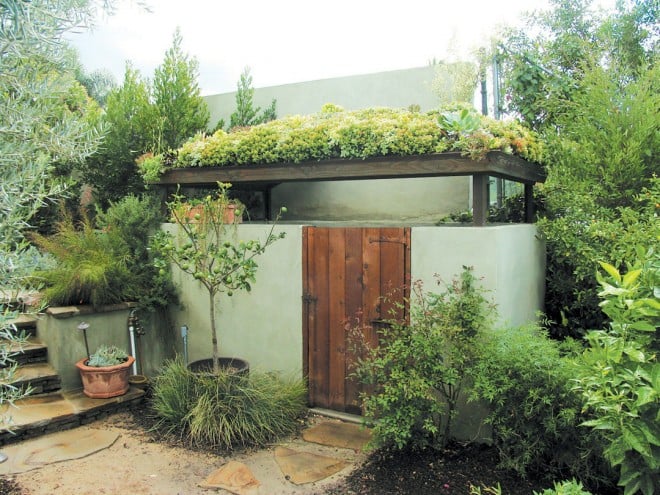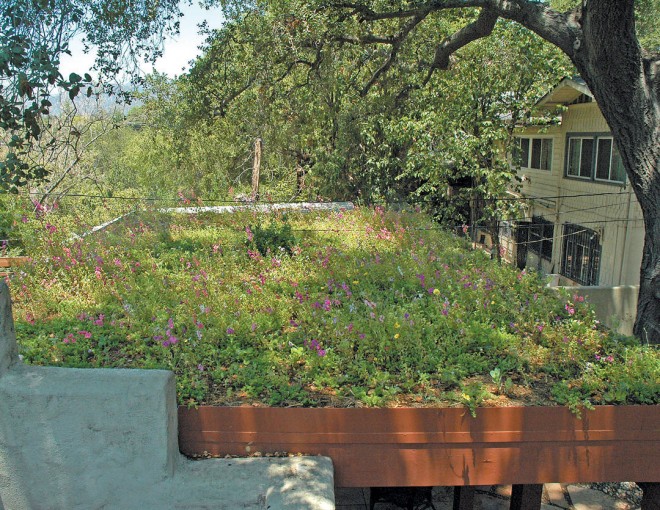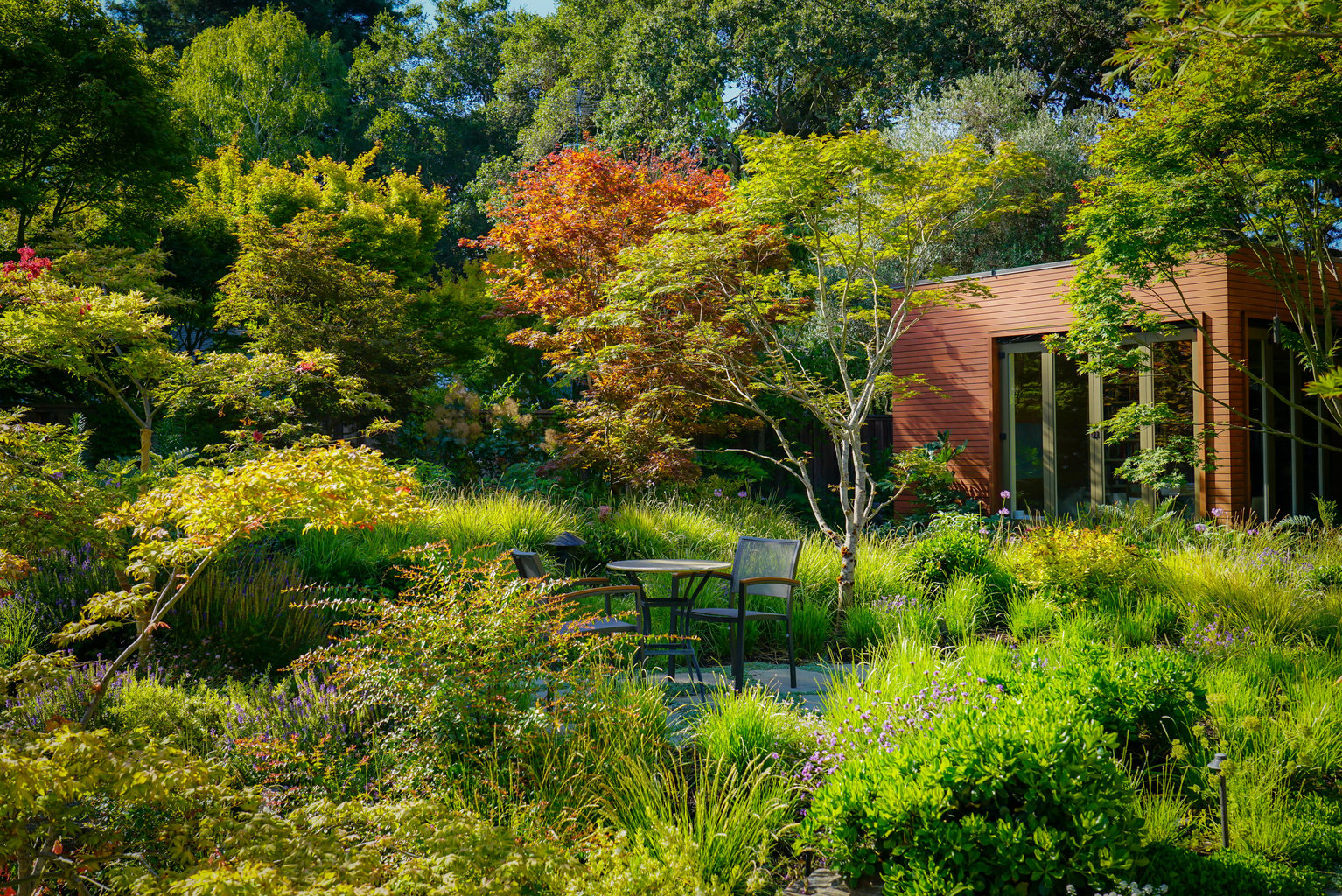
Up on the Roof

Contributor

[sidebar]Over-the-top planting schemes are aesthetically and environmentally savvy. They save energy. They reduce runoff. And they’re beautiful—like living tapestries. [/sidebar]
Plant a rooftop; change your life. That’s Pamela Berstler’s mission. By converting conventional heat-generating roofs into energy- saving ecosystems where succulents and wildflowers flourish, the West Los Angeles-based landscape designer hopes to transform the local landscape, one green roof at a time. A partner with her husband Alex Stevens in Flower to the People, Berstler designs green roofs for residential clients. She believes homeowners should emulate the green building industry and plant eco-friendly rooftops that absorb and filter storm water, insulate their surroundings against extremes of heat and cold, and put oxygen back into the atmosphere. Not the least among its many benefits, an energy-efficient living roof can also be beautiful.
Planted roofs are widely used in Europe and even in some American cities like Chicago, which has spent the past decade encouraging commercial and residential homeowners to mitigate high energy costs with green roofs. Pasadena recently included green roofs as an element of mandatory green building policies for new municipal buildings. But much of Southern California’s residential rooftops are still sheltered by traditional materials like tile, shingles, or composite sheeting. Homeowners have been slow to join the green roof revolution, in part because of structural logistics and costs.
A green roof’s structure needs to be substantial enough to carry the weight of wet soil and plants. For new construction, it’s possible to engineer a roof to accommodate the weight and drainage requirements. Existing rooftops (such as a porch, carport, or shed roof) may need added strengthening. It is best to first hire a structural engineer or an experienced contractor to check the integrity of a roof before it is planted.
To design and plant a green roof, including the waterproofing and drainage systems, most projects will run between $30 and $40 per square foot, according to Berstler. The average cost per-square-foot decreases as the size of the roof increases.
“The bottom line is that green roofs can make Los Angeles a much better, more livable city,” said Steven Peck, founder and president of Green Roofs for Healthy Cities, a Toronto-based nonprofit association for the green roof industry. “But we’re not talking about a technology where you can go to Home Depot and do it yourself.”

A Patio Roof
After reading about green roofs in a home design magazine, Susan Jenkins and Rene Maza of Altadena wanted to convert an ordinary patio roof into a planted garden-in-the-sky. Recognizing the need for professional help, the couple hired Flower to the People to plant their patio roof with sedums and a wildflower seed mix. Before installing hundreds of tiny succulents and sowing flowers like yarrow, poppy, and clarkia, Berstler worked with Doug Kilpatrick of La Crescenta-based Foothills Construction to ensure the wood-framed structure would handle the weight of the living roof. The contractor reinforced the 300-square-foot patio roof so it could support Berstler’s green roof system.
A root barrier and a drainage mat are sandwiched together on top of a one-half-inch layer of pea gravel and a waterproof membrane. Metal flashing protects the roof’s framework from moisture. Together, this system creates a “tray” in which the succulents are planted.
Green roofs require four to six inches of soil depth for roots to grow. Rather than using soil, Berstler prefers a lightweight medium such as compact moss or a custom planting mixture. The plantings can be hand-watered during dry spells or irrigated with low-flow spray heads that apply approximately one-third the water of a regular spray head.
Succulents are ideal for green roofs because of their low-water requirements and heat-loving characteristics. Whether randomly planted or arranged in a pattern, these hard-working perennials grow quickly during the first year or two, filling in gaps to hide the planting medium. The result is like a meadow, rather than a container of individual plants.
Without a green roof to gaze on, Jenkins and Maza would have otherwise stared at a huge rectangle of black tarpaper. “We can’t actually see most of our garden from the house, so we gain a lot of visual pleasure from having a living roof,” Jenkins said. “It makes our garden look finished and feel cooler.”

Roof-top Turf
Traditional sod roofs are an option in more temperate climates, such as the San Francisco Bay Area. Designers David McCrory and Roger Raiche of Napa-based Planet Horticulture, recently used a dwarf fescue grass called ‘No-Grow’ for the roof of a client’s backyard dining pavilion in the town of Woodside, on the San Francisco Peninsula. The structure was a folly-like take on the Norwegian-style timbered architecture of the client’s house. They wanted a wild and unkempt look, like the turfed roofs of European houses. The wildness is enhanced by windborne seeds and those dropped by birds using the living roof as a suburban habitat.
Similar to Berstler’s method, McCrory and Raiche used a waterproof membrane to protect the dining pavilion, which was constructed from reclaimed old growth redwood. A custom planting medium that includes coconut coir (a sustainable alternative to peat moss) is lightweight but holds moisture and drains well. A micro-spray irrigation system is used during dry months.
Planting Pillows
When they renovated the garden surrounding their 1950s home in Sherman Oaks, actors John Carroll Lynch and Brenda Wehle wanted to hide the pool equipment and trash bins. Their landscape designer, Marilee Kuhlmann of Los Angeles-based Comfort Zones Garden Design, suggested covering the fenced utility spaces with a green roof that would capture and clean rainwater, reduce the “heat island” effect created by the pavement, and be a lot more attractive than the pool equipment. Kuhlmann tapped Berstler to consult on the project, which yielded a pair of abundantly planted succulent roofs.
Berstler fabricated planting “pillows,” each one an eighteen-inch-square by four-inch deep modular section filled with tightly wrapped moss. She inserted cuttings of crassula, aeonium, echeveria, and other succulents into the moss, planting them densely to create a verdant and textural landscape that’s a lot more attractive than a composite roof or exposed mechanical equipment. When fitted together on the roof, the succulent cushions create a seamless landscape that is as attractive as a tapestry. The roof has a slight slope that ensures that any precipitation will gently drain off the roof, rather than leave the roots in standing water.
Since the green roofs were completed in 2005, maintenance has been minimal. The designers like to trim any leggy succulent stems and re-insert them into the growing medium, thereby creating an even fuller design. During extended dry periods, the roofs are hand-watered once or twice monthly.
Peck, of Green Roofs for Healthy Cities, believes that more homeowners will embrace the environmental and aesthetic value of green roofs if there are incentives in place to help them. He acknowledges the public and private benefits of green roofs, but suggests that cities need to help bring down their costs.
Berstler agrees. “It’s a huge commitment to transform an entire roof, which is why I’m interested in first designing green roofs for sheds and small outbuildings,” she said. “When people see small, artful rooftops in a landscape, they can begin to visualize an entire home with a living roof. It would be easy to treat living roofs as merely a fad, but this is what our future looks like.”
Share:
Social Media
Garden Futurist Podcast
Most Popular
Videos
Topics
Related Posts

Low Maintenance Gardens – Better for Pollinators and People
Autumn 2022 “I come out every day. It’s therapy, my meditation.” Janet’s young garden transformed from overgrown, invasive plants to mostly natives. The dailiness of

Invasive Plants Are Still Being Sold: Preventing Noxious Weeds in Your Landscape
Autumn 2022 With so many beautiful ornamental plant species and cultivars throughout California and the Pacific Northwest, how do you decide which ones to include

Garden Design in Steppe with Transforming Landscapes with Garden Futurist Emmanuel Didier
Summer 2022 Listen to full Garden Futurist: Episode XVII podcast here. Emmanuel Didier, Principal and Creative Director at Didier Design Studio is a leading figure

Seslerias: Versatile Groundcover Meadow Grasses
Summer 2022 Without question, the most beautiful and versatile of all the groundcover meadow grasses are the moor grasses (Sesleria). Moor grasses tick off all











Responses